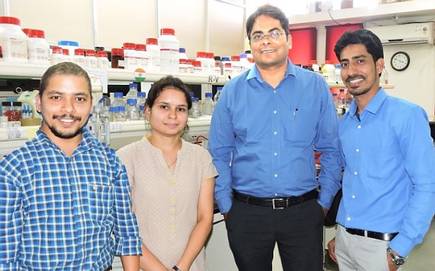
Scientists identify a new way to tackle tuberculosis
 Indian scientists identify three sites in the genome of the tuberculosis-causing bacterium that could be used as targets to kill it. The study was conducted by the researchers from Indian Institute of Technology (IIT)-Indore, Translational Health Science and Technology Institute (THSTI), Faridabad, All Indian Institute of Medical Sciences (AIIMS), New Delhi, and University of Bordeaux, France.
Indian scientists identify three sites in the genome of the tuberculosis-causing bacterium that could be used as targets to kill it. The study was conducted by the researchers from Indian Institute of Technology (IIT)-Indore, Translational Health Science and Technology Institute (THSTI), Faridabad, All Indian Institute of Medical Sciences (AIIMS), New Delhi, and University of Bordeaux, France.
DNA, the basic building block of the genome of any organism, is made of nucleotides, which are strung together in a row. Each nucleotide has one molecule both sugar and phosphate as well as nitrogenous base carrying genetic information in nucleobases — adenine, cytosine, guanine, and thymine (A, C, G, and T).
The genome of an organism comprises of arrangement and combination of these nucleobases with unique features that can be explored for drug development. According to studies, in regions of the genome rich in guanine, nucleobases bond together in groups of four forming what are called tetrad structures. These tetrads stack upon each other to form stable secondary structures known as G-quadruplexes which plays a role in regulating biological processes like replication. The research team have analysed the genome of Mycobacterium tuberculosis and identified three G-quadruplex motifs that could be used as drug targets. Then the team explored the role of G-quadruplexes in three genes — called espK, espB and cyp51 of Mycobacterium tuberculosis. Products of the three genes are involved in pathways responsible for determining the virulence of the bacteria and in ensuring its survival inside human cells. Later, bioinformatics, biophysical and cell-based studies showed that targeting the three G-quadruplexes could help decrease the virulence of the bacteria and its survival.
The researchers have published a report on their work in the journal Molecular Therapy-Nucleic acid. The team included Subodh Kumar Mishra, Uma Shankar, Neha Jain (IIT-Indore); Kriti Sikri, Jaya Sivaswami Tyagi (AIIMS); Tarun Kumar Sharma (THSTI) and Jean-Louis Mergny (University of Bordeaux). “We are presently screening several small molecules that could be used to target these genes. We are hopeful to find a lead candidate in near future,” said Dr. Amit Kumar of IIT Indore, while speaking to India Science Wire.
Source: FirstPost, Down to Earth.
Image: The Hindu Businessline